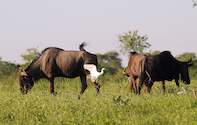
About the South West
At Malelane Gate
Malelane Skukuza via Afsaal
Malelane Skukuza via Biyamiti
Malelane to Berg-en-Dal
Malelane to Crocodile Bridge
Matjulu Loop
Numbi Gate
Numbi Gate to Skukuza
Pretoriuskop Area
Pretoriuskop to Malelane
See a map of South West Kruger Park
Pretoriuskop to Albasini Road (S7)
Although they are not often seen around Shabeni, there are lion in the area. Ranger Harry Wolhuter once came across a curious sight during a patrol here in 1938. At the foot of Shabeni was a car with a flat tyre. A tourist was busy trying to change the wheel and had not noticed a lion in the grass four metres away, watching him curiously. Wolhuter yelled at the man to get back into his car and, as he did so, the lion pounced - but it was after the bedroll that the spare wheel had been resting on, and not the tourist. The bedroll was found the next day in the grass nearby, completely shredded.One can either take the loop back to Pretoriuskop or continue on the Albasini Road through the beautiful granite koppie landscape towards Phabeni. Along this road is the site of one of the world's longest-running experiments into the effects of burning. Begun in 1954, the study investigates the interaction between fire and rainfall on tree and grass growth.
Originally, Pretoriuskop was a stopover on the route from Lydenburg to Delagoa Bay (Maputo) by the transport riders of the 1800s. It gets its name from the Voortrekker Willem Pretorius, who died here in 1845 and was buried by João Albasini. His grave can be seen soon after entering the Park on the main Skukuza road (H1-1).

Changing Landscapes
The animal life around Pretoriuskop has undergone a radical change in the last century. Up until 1924, the area was used for winter grazing by livestock farmers who burned the veld each year. This kept tree growth to a minimum and attracted grazers such as zebra, wildebeest and sable antelope.
When the Kruger National Park was proclaimed that year, the winter grazing rights fell away and the bush began to revert to its natural state - within a few decades, thick terminalia kiaat woodland replaced the grasslands around Pretoriuskop attracting browsers such as kudu, and encouraging the grazers to head into the eastern sweetveld plains.
To the south of Pretoriuskop camp is the distinctive mountain Manungu (689m), named after a local chief of the same name who ran a trading store and livestock camp between 1845 and 1853. Manungu was part of Albasini's retail network, which serviced transport riders and other travellers moving between the mining towns of the interior and Delagoa Bay.
Fayi Loop (S14)

This is one of the better places in the vicinity for seeing lion. In 1886 a hunting party led by veteran hunter Gert Stols was camping near Fayi Creek, when they were attacked by two lions. Several oxen were killed before the lions were driven off into the night. \ Stols set up an ambush the next day using one of the dead animals as a lure.
The lions walked into his trap and he shot one dead and wounded the other. The hunters pursued the wounded cat into the Fayi Creek gully where they in turn were ambushed. The injured lion leapt out of the thick grass, savaging one of the hunters before turning on Stols.
Stols shot it dead. Ironically he survived the lion encounter only to die that night of a heart attack. He was buried near what is today known as Stolsnek.

The Magic Guarri Tree The magic guarri (Euclea divinorum) acts as an early warning beacon to other trees in times of impending drought. Distributed throughout the Park, this slow-growing, dense evergreen shrub produces a pheromone when it becomes stressed.
This triggers the release of tannin in the leaves of surrounding trees which makes them unpalatable to browsers such as kudu. The increase in tannin content is a self-protection mechanism that prevents the bush from being eaten out.
The Guarri itself is not favoured by animals, although birds like its fruit. Alcoholic beverages have been made from the fruit, while twigs broken off from the tree were used as toothbrushes in the old days because of the fibrous texture.

 Pretoriuskop Camp is the oldest Rest Camp in the Kruger Park and holds a large population of White Rhino. Accommodation at Pretoriuskop Rest...
Pretoriuskop Camp is the oldest Rest Camp in the Kruger Park and holds a large population of White Rhino. Accommodation at Pretoriuskop Rest...